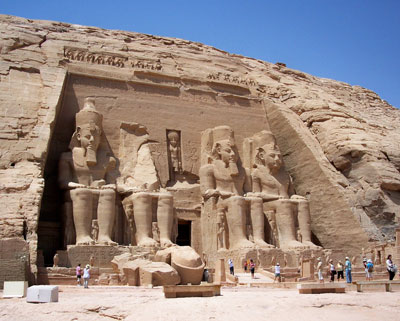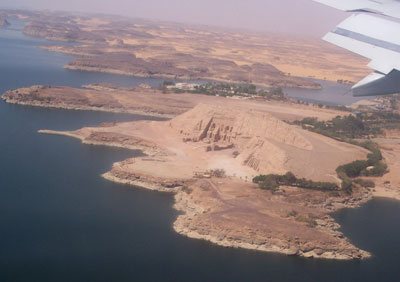Abu Simbel to Luxor
This item appears on page 69 of the March 2010 issue.
(Part 3 of 3 on Egypt)
One of the highlights of my fall ’09 Egypt adventure with Value World Tours was a day excursion from Aswan to Abu Simbel. Most fortunately, I was scheduled to fly to Abu Simbel, which reduced travel time to and from the site dramatically and also provided awe-inspiring aerial views of the fabulous twin monuments.
I later learned that the vast majority of day-trip visitors to Abu Simbel travel by road in required bus and auto caravans across the sometimes-treacherous desert, 280 kilometers in each direction. Flying, I would thankfully be back in Aswan by early afternoon.
The majesty of Abu Simbel
Among the most overpowering monuments in the world, the two temples at Abu Simbel are also famous for their removal and reconstruction when threatened by submersion in the rising waters of Lake Nasser after completion of the High Dam in Aswan.
With the support of UNESCO and a worldwide appeal, Egypt was able to orchestrate a Herculean salvage effort. Between 1964 and 1968 the monuments were dismantled and carefully reassembled 60 meters up the sandstone cliff, utilizing the expertise of both engineering technologists and antiquity experts from around the world.
Abu Simbel features a unique design. Its rock-strewn “grotto” temples are unusual in Egypt and, though common in Nubia, there are no other examples of twin sanctuaries in that region.
Also unlike other Nubian temples, Abu Simbel’s temples were never converted into a church and were left alone, apparently untouched by later religions until the time of their rediscovery and recovery from the sand in 1817. At Abu Simbel, these sanctuaries are dedicated to Ramses himself and his beloved wife Nefertari. I was perhaps most impressed by the six colossal, carved, rock statues adorning the façade of the smaller temple.
Several guides advised that the sound-and-light show at Abu Simbel is the best in Egypt due to the magical setting.
Rest, recovery & more temples
Upon my return by air to Aswan I reboarded our ship, Crown Prince, for our cruise back downriver toward Esna. Temperatures had reached 116 degrees by the conclusion of my walking tour back in Abu Simbel, so some relaxing recovery time was in order.
I cannot overstress the importance of heavy advance and continued hydrating with water, specifically in such warm areas. If you don’t begin drinking water until you feel thirsty, you are already dehydrated and putting your body under great stress.
The following day, after the ship was docked in Luxor again, I visited the renowned Karnak Temple complex, located just three kilometers from the Luxor Temple. Karnak consists of three large temples constructed on 100 acres whose history spans 13 centuries. The Avenue of Ram Sphinxes’ huge statue of Ramses II and his wife Neferati were, for me, the most impressive features.
A swan-song cruise to Quena
From Luxor, the following morning we began a one-day cruise excursion 60 kilometers north to Quena, where we explored the Greco-Roman temple of Dendera, built for the worship of the goddess Hathor. This was the final temple visit of my memorable week on the Nile.
After returning to the boat, we sailed back upstream to Luxor. That final afternoon aboard the Crown Prince, most passengers remained on deck realizing it was their final opportunity to experience the live-action, wide-screen viewing of life along the river.
There, life is reduced to the most basic common denominators: work, eat, sleep, play and pray, all with the sense that life must be lived in cooperative unison with others in the immediate. It is little wonder foreign visitors view the simple riverside lifestyle of the locals with a combination of fascination and admiration.
My Egypt adventure was taken courtesy of Value World Tours (Fountain Valley, CA; phone 800/795-1633, e-mail cruise@valuecruises.net), an ITN advertiser, who operates a wide variety of river cruise programs to destinations throughout world. The Egyptian Tourist Authority and EgyptAir also assisted with my journey.
Keck's Beyond the Garden Wall
❝ Shall the lessons of the ancients translate,
Shall the greater species know evolvement,
Shall inhumanity submit to humanity,
Self to selflessness,
Or shall those basic truths remain adrift,
The province of worlds beyond? ❞
— Randy reflecting on humankind’s historical inability, over centuries of opportunity, to apply the Golden Rule to its evolvement.


